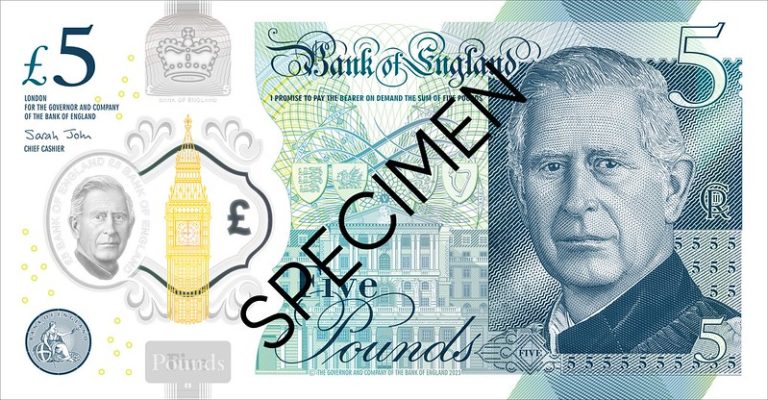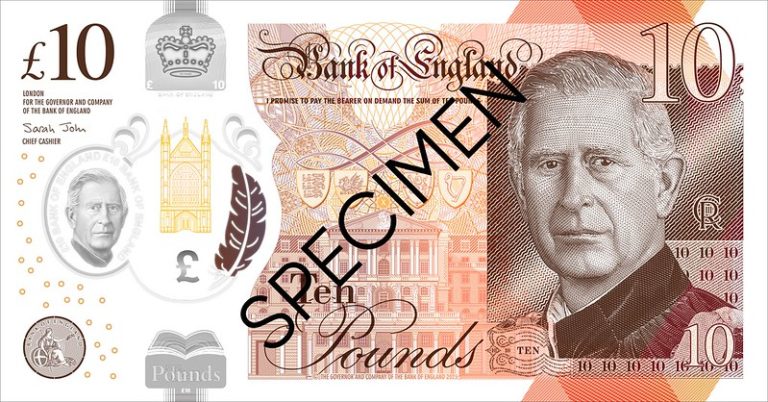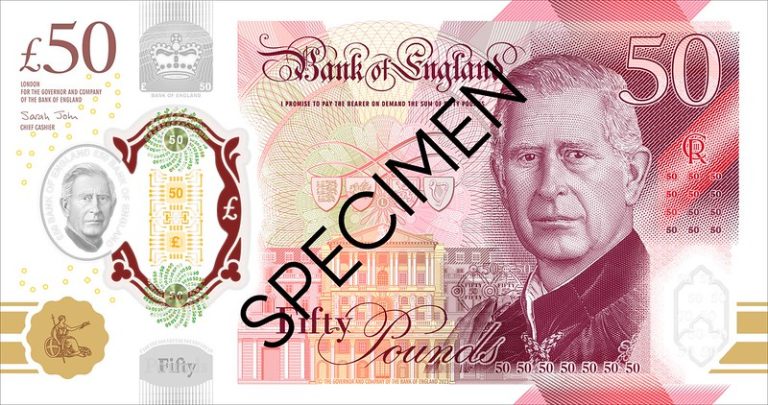A Royal Makeover: Cash After Elizabeth II
CurrencyThe money used in a particular country at a particular time, like dollar, yen, euro, etc., consisting of banknotes and coins, that does not require endorsement as a medium of exchange. More of the Realm: Queen Elizabeth II (1926-2022)
“[Updating cash] may have a practical use in the fact that it obviously marks a difference from the previous reign.” – Nigel Fletcher, teaching fellow at King’s College London.
By her death on September 9, 2022, Queen Elizabeth II’s head appeared on all 4.7 billion individual Bank of England (BoE) notes (worth about £82 billion) and approximately 27 billion coins currently in circulation.
The Queen’s silhouette has also appeared in all 220 billion Royal Mail stamps since 1967. Nearly 61.4% of the U.K.’s 115,000 postboxes carry Queen Elizabeth’s mark, EIIR (Elizabeth II Regina). The legendRefers to the lettering, words or phrases that are engraved on coins, usually located along or around the outside edge of the coins. More “Her Majesty” appears prominently in passports and official stationery.
Updating banknotes, coins, stamps, and stationery will take time. “Most of the events accompanying or following accessions in the modern era, including in 1952, have simply followed what had happened the last time as a matter of habit, or resolution upon ‘how these things are done’—not a set of procedures prescribed by law,” said Robert Blackburn, professor of constitutional law at King’s College London.
Queen Elizabeth did not carry cashMoney in physical form such as banknotes and coins. More except on Sundays. In 2015, a source revealed that “she donated to the church collection basket. Her butler irons a five-pound note into a little square by folding it until you can only see her face.”
Banknotes
“On behalf of everyone at the Bank I would like to pass on my deepest condolences to the Royal Family. For most of us, she is the only head of state we have ever known, and will be remembered as an inspirational figure for our country and the Commonwealth.” – Andrew Bailey, BoE governor
After the BoE received permission from the U.K. Treasury to use the Queen’s portrait in 1956, Queen Elizabeth II became the first monarch to appear on BoE notes in 1960, with the £1 note. Six Scottish and Northern Irish banks issue notes which do not depict the British monarch.
As the royal succession occurs, the BoE is still replacing paperSee Banknote paper. More banknotes with polymerA substrate used in the printing of banknotes, made of biaxially oriented polypropylene (BOPP) polymer. Polymer banknotes were first introduced in Australia and are widely used around the world. More ones.
- In 2016, the BoE launched a £5 note depicting Prime Minister Winston Churchill.
- A year later, the BoE started issuing a £10 banknoteA banknote (or ‘bill’ as it is often referred to in the US) is a type of negotiable promissory note, issued by a bank or other licensed authority, payable to the bearer on demand. More honoring novelist Jane Austen.
- Launched in 2020, the BoE’s new £20 note depicts the artist J.M.W. Turner.
- Last year, the BoE launched a polymer £50 note featuring gay mathematician Alan Turing. All paper £20 and £50 notes were withdrawn from circulation after September 30, 2022.
“In line with guidance from the Royal Household to minimise the environmental and financial impact of the changeThis is the action by which certain banknotes and/or coins are exchanged for the same amount in banknotes/coins of a different face value, or unit value. See Exchange. More of monarch, existing stocks of notes featuring HM Queen Elizabeth II will continue to be issued into circulation. New notes will only be printed to replace worn banknotes and to meet any overall increase in demand for banknotes,” said the BoE.
On December 20, 2022, the BoE unveiled banknotes featuring King Charles III (see Figure 1). These notes will enter circulation by mid-2024. The King’s portrait will appear on all four polymer notes (£5, £10, £20, and £50). The rest of the design on the banknotes will remain the same.
Figure 1. Bank of England: £5, £10, £20, and £50 Banknotes Depicting King Charles III
Source: BoE (2023).
Coins
“The Royal MintAn industrial facility manufacturing coins. More worked with Her Late Majesty throughout her reign – detailing her journey from new Queen to respected head of state across five coinA coin is a small, flat, round piece of metal alloy (or combination of metals) used primarily as legal tender. Issued by government, they are standardised in weight and composition and are produced at ‘mints’. More portraits, and ensuring each new UK coin received her personal seal of approval. The remarkable legacy of Britain’s longest serving monarch will live on for many years to come.” – Anne Jessopp, CEO at The Royal Mint
Queen Elizabeth II’s face started appearing on all U.K. coins in 1952, a year after her ascension. The Royal Mint’s most recent design of Queen Elizabeth II’s portrait was launched in 2015; it was the fifth coin portrait created during her reign.
It was customary to find multiple monarchs in small change until British coins were updated for decimalization in 1971, including “Queen Elizabeth II, George VI, George V. Maybe even some really old coins featuring Queen Victoria,” said Dominic Chorney from coin specialists A.H. Baldwin & Sons.
Video 1. Royal Mint: First Coins Depicting King Charles III
Source: Royal Mint (2023)
The first coins depicting King Charles III will enter circulation in line with demand from “banks and post offices,” said Anne Jesopp, CEO of The Royal Mint (see Video 1).
“Although I am the original designer, there are a number of skilled experts here at The Royal Mint. Every aspect of this has been pored over by all of us. It really has been a pieceIn plural, it is commonly used as synonym for units of banknotes and coins. More of teamwork that I have been absolutely delighted to be a part of.” – Martin Jennings, sculptor and designer of King Charles III’s first official coinage portrait
Whereas Queen Elizabeth II’s coinage portraits show her facing right, coins with King Charles III will depict him facing left. New kings and queens faced the opposite direction of their predecessors on currencies since the end of Oliver Cromwell’s Protectorate and the reign of Charles II (1660-1685), except for Edward VIII, who was king for less than a year in 1936.
Costs of a Royal Makeover
“The cost of the monarchy, which is significant, comes with the ongoing costs which ought to be reined in and haven’t been reined in.” – Norman Baker, former government minister and author.
Current banknotes and coins will continue to be legal tenderMoney that is legally valid for the payment of debts and must be accepted for that purpose when offered. Each jurisdiction determines what is legal tender, but essentially it is anything which when offered (“tendered”) in payment of a debt extinguishes the debt. There is no obligation on the creditor to accept the tendered payment, but the act of tendering the payment in legal tender discharges the debt. More, per the BoE and the Royal Mint, as updating the U.K.’s cash supply will be a multi-year process. Royal stamps will remain valid until the end of January 2023.
Rolling out the new physical moneyFrom the Latin word moneta, nickname that was given by Romans to the goddess Juno because there was a minting workshop next to her temple. Money is any item that is generally accepted as payment for goods and services and repayment of debts, such as taxes, in a particular region, country or socio-economic context. Its onset dates back to the origins of humanity and its physical representation has taken on very varied forms until the appearance of metal coins. The banknote, a typical representati... More will “not happen overnight,” said Ethan Ilzetzki, associate professor at the London School of Economics.
- According to Mauro F. Guillén, dean at Cambridge Judge Business School, the cost of creating new molds to print updated banknotes would be “relatively negligible.” Updating notes would take 2 to 4 years.
- Rebranding coins will take longer and be more expensive, given their durability. Pound coins can typically circulate for 30 years. Guillén estimates it would take at least $600 million to renew coinage.
Global Redesign
Queen Elizabeth II’s image has appeared in the currencies of 33 different countries (more than any other individual) with 26 portraits. Updating cash with her effigy will extend to 15 nations where the Queen was head of state (including Canada, Australia, and New Zealand) and 50 Commonwealth nations.
Canada
- Canada was the first nation to use the British monarch’s image in its currency, putting the 9-year-old Princess on its CAD20 notes in 1935.
- “The current polymer CAD20 banknote [designed in 2018] is intended to circulate for years to come,” said the Bank of Canada (BoC).
- According to a Royal Canadian Mint spokesperson, the Canadian government will decide if new coins will feature King Charles III.
Australia
- The Reserve BankSee Central bank. More of Australia (RBA) said that it will keep its AUD5 banknotes (worth more than AUD1 billion) featuring the late Queen in circulation “for years to come.” Still, it will launch new coins as early as 2023.
New Zealand
- “The Queen is likely to remain on NZD20 banknotes issued from existing stock for many years to come. We manufacture these notes infrequently and do not plan to destroy stock or shorten the life of existing banknotes just because they show the Queen. This would be wasteful and poor environmental practice,” said the Reserve Bank of New Zealand (RBNZ).




